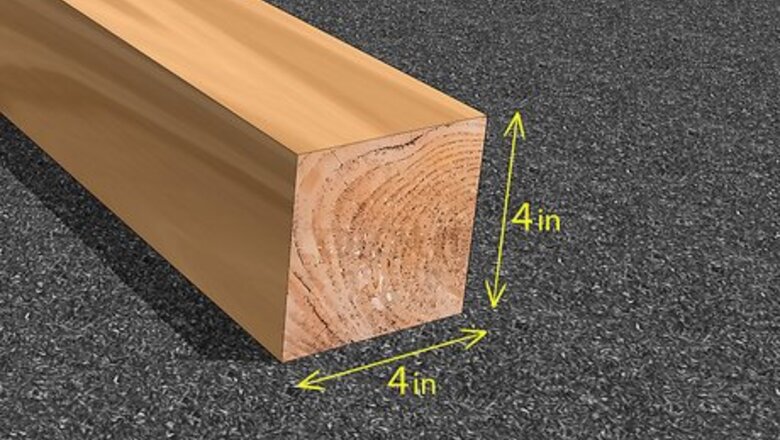
views
X
Research source
Cutting the Wood
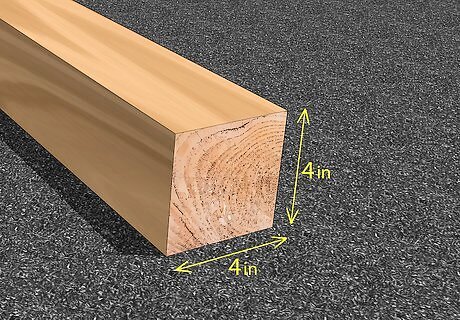
Purchase pressure-treated wood to make the base of the trap. Carpenter bees build their nests in soft pieces of wood, so avoid untreated lumber. Head to a hardware store or repurpose any wood scraps you have laying around. Pine and cedar are a couple of options for an inexpensive but effective trap. For an easy trap that doesn’t require a lot of cutting, get: A 4 in × 4 in (10 cm × 10 cm) wood post at least 7 in (18 cm) in height. Pressure-treated wood often has a faint green hue and smells like oil. The wood may also have a stamp like “L P22” on it to indicate that it has been treated. You can design your trap differently if you wish to. For instance, if you’re good with crafts, try cutting boards and nailing them together to make a square box.
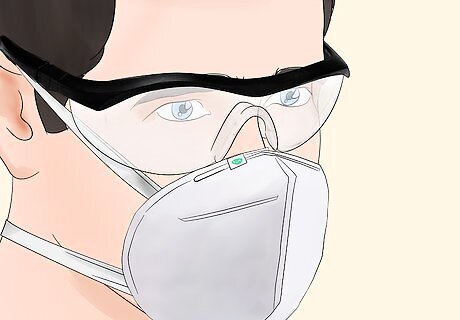
Put on eye goggles and a dust mask before working on the trap. Whenever you plan on cutting or drilling wood for the trap, cover up to avoid sawdust and wood shards. Keep other people out of the areas while you work. Consider also working outdoors or ventilating your workspace by opening nearby doors and windows. Wear a short-sleeved shirt so you don’t have to worry about loose fabric getting caught in your tools. Also, don’t wear jewelry and tie back your hair if it is long.
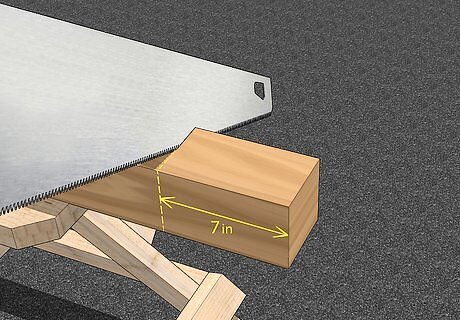
Cut the wood post until it’s 7 in (18 cm) in length. If you’re working with a long post, trim it to size first. Measure up from one end of the post and mark the distance in pencil. Then, use a circular saw or handsaw to cut horizontally across the post. Set aside the part you aren’t planning on using for the trap. The post doesn’t have to be very long in order to direct bees into the trap. In fact, leaving the post relatively small makes the trap easier to handle. If you have excess wood to spare, you could make additional traps with the material you cut.
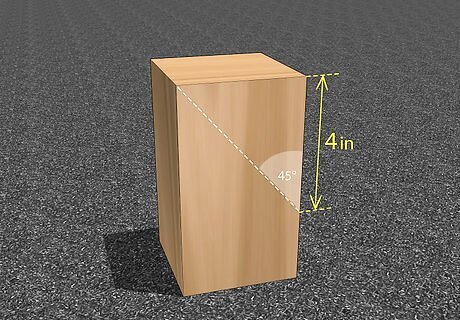
Measure and mark a diagonal angle at the top of the post. Measure about 7 in (18 cm) up along one side of the post. Make another mark about 4 in (10 cm) up the opposite side of the post. Use a ruler to draw a diagonal line connecting the points. The line will be at about a 45-degree angle and is used to cut the top part of the trap. Making this angle helps later with creating tunnels for the bees to enter. You could also do it without cutting the post at an angle, but it makes the tunnels trickier to line up. If you don’t wish to do this, you could leave the top alone and instead make a tunnel all the way through the post. Then, cover the top hole with a plank so the bees can’t escape that way.
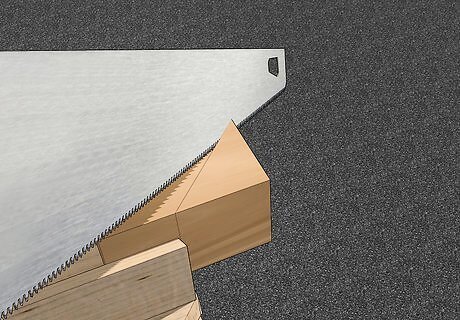
Use a saw to trim the post along the traced line. Hold the post still again. To make the cutting process easier if you’re using a handsaw, pin it to a workbench or sawhorse with a bench clamp. If you’re using a circular saw, hold the wood so the saw slices across the line you made. This will leave the post with an angled top you can use to hang the trap later. The angled top prevents light from filtering into the trap’s tunnels, so the bees won’t have as much of an opportunity to escape. If you don’t plan on cutting the top, try nailing a board to it. The board will cover up any holes as well as give you a place to safely install a hanging mechanism.
Creating the Bee Tunnels

Drill through the bottom of the post using a ⁄8 in (2.2 cm) bit. Flip the post over so the flat, bottom edge faces upward. Position the drill bit directly over the center of the post. Carefully drill straight down, creating a hole about 4 in (10 cm) deep. You can measure your drill bit ahead of time to ensure the hole is the correct length. If the drill bit is too long, mark it with tape so you know when to stop drilling.
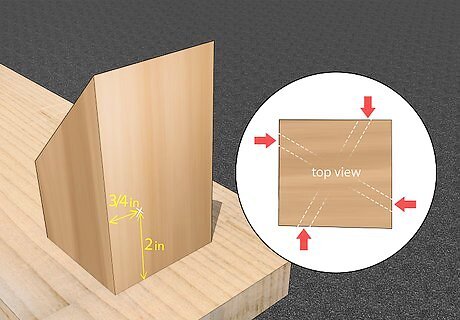
Mark entry holes 2 in (5.1 cm) up the sides of the post. Measure up from the bottom edge of the post on one side. The holes also need to be about ⁄4 in (1.9 cm) from the sides of the post in order to keep your trap sturdy. Mark the spot in pencil, then repeat the process on the other 3 sides. Make sure the marks are well-positioned before you start drilling! These will be the entrance points for the bees, so if they aren’t in the right spot, they won’t connect.
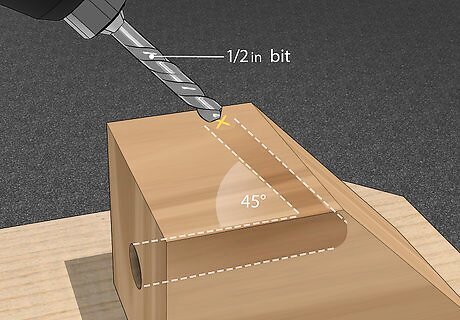
Position a ⁄2 in (1.3 cm) drill bit diagonally on the mark. Lay the post flat and start with one of the marks you made on the sides of the trap. Point the drill bit up toward the top of the trap at a 45-degree angle. If you angle the drill properly, the new holes will end up connecting to the center tunnel, giving the bees nowhere to go but down. The tunnels have to be angled upward in order to prevent light from getting into the trap. It causes the bees to head toward the clear jar placed at the bottom of the trap.

Drill through the marks you made on the trap’s sides. Drill all the way in until you reach the center of the trap. The hole needs to be about 4 in (10 cm) deep. You will eventually feel the drill bit reach the initial tunnel you made through the bottom of the post. Drill through the remaining sides make a few entrances for the bees. Drill the other marks as well to make multiple ways for the bees to crawl into your trap. If you aren’t able to connect the tunnels together, don’t worry. You could try widening the holes or drilling down through the top of the post to connect them all.
Installing the Trap
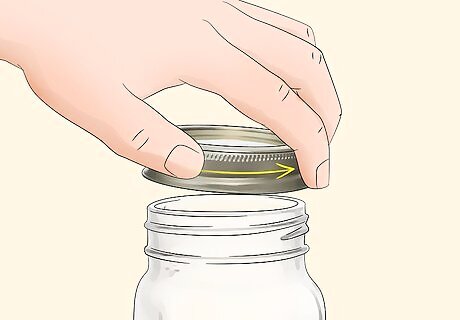
Twist the lid off of a Mason jar. A half-pint jar has a lid about 2.8 in (7.1 cm) wide, the perfect size for your trap. Turn the metal ring on top of the jar counterclockwise by hand to free the lid. The lid is the flat piece of metal inside the ring. Pick up the lid and set it aside. If you don’t want to use a breakable jar, get a few plastic soda bottles instead. Try cutting open one bottle and stapling the bottom half to the trap. Fit a second bottle half over it to hold the bees.

Use a marker to mark the spots you need to punch through the lid. Use a ruler to measure the lid’s diameter. Find where the center is and mark it. Then, calculate the halfway points between the center and the rim of the lid. Mark these spots as well. Make sure you measure across the center of the lid. Hold the ruler very still until you’re done so the spots are properly aligned. The center marking will be an opening for the bees to crawl through. The other spots are there to secure the lid to the trap.

Use a metal punch to poke holes through the lid. Set the lid on top of a piece of scrap wood. Then, position a metal punch over one of the marks. Hammer the opposite end of the punch until it breaks through the lid. Repeat this with the other marks you made.. The punch can damage any surface underneath it. Work over something you don’t plan on keeping, such as a piece of scrap wood.
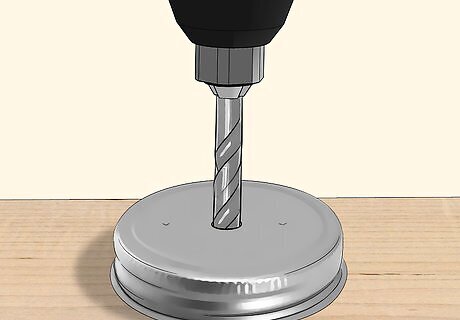
Widen the center hole using a ⁄2 in (1.3 cm) metal drill bit. This time you’re going to need to drill through a harder material, so make sure you’re using a heavy-duty bit designed to cut through metal. Drill down through the center hole to widen it. Keep widening it until it matches the tunnel hole you made on the bottom of the wood post. Be careful not to damage anything underneath the thin lid. Hold it down firmly against a piece of scrap wood that the drill bit can pass through without issue. Throw away the scrap wood when you’re done. If you use the wrong drill bit, it could burn out your drill as well as ruin the lid, so choose carefully.
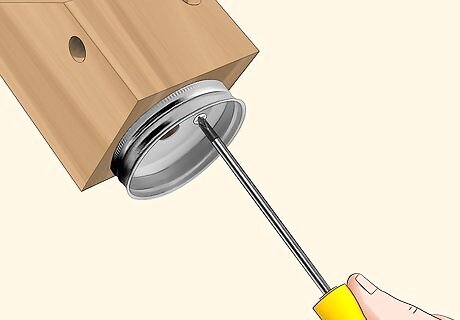
Screw the lid to the underside of the trap. Place the lid back inside the Mason jar’s ring. Then, position the ring over the hole on the bottom edge of the wood post. Fit a pair of ⁄2 in (1.3 cm) wood screws into the smaller holes you punched through the lid. Finish securing the lid by using a screwdriver to turn the screws clockwise. Screw the holes straight into the wood so they don’t end up crossing into the bee tunnel. Then, make sure the lid is securely in place before attempting to position a Mason jar on it.
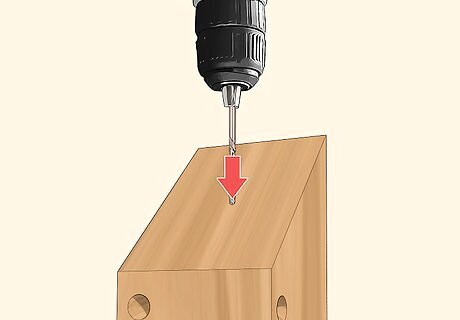
Make a pilot hole through the trap’s top if you plan on hanging it. You will need a wood drill bit approximately ⁄8 in (0.32 cm) in size. Flip the trap over so the Mason jar side is facedown. Position your drill bit along the center of the trap, then drill down into it. This hole only needs to be short so it doesn’t reach the bee tunnels you made earlier. The length of the hole depends on the length of the eye screw you plan on using. It needs to be the same length as the screw. Normally, it will be 2 in (5.1 cm) or less. If you made your bee trap differently, be careful not to drill all the way through the wood. For instance, if you made a box using flat boards, don’t let the drill pierce through the top of the trap.

Twist an eye screw into the hole to hang the trap. Use a screw the same length as the hole you made. Set the screw end in the hole, then turn it clockwise until it feels tight and sturdy. You can then hang the trap by threading a rope or a hanging hook through the screw’s eye. Find space for the trap near your deck or other spots carpenter bees tend to invade. Hang the trap near where you notice bees or near spots you think they might visit. With a screw hook, you can hang up a trap just about anywhere. If you’re not planning on hanging the trap, set it up on a stable surface near where the bees gather. Put it up high, such as on a table or railing.
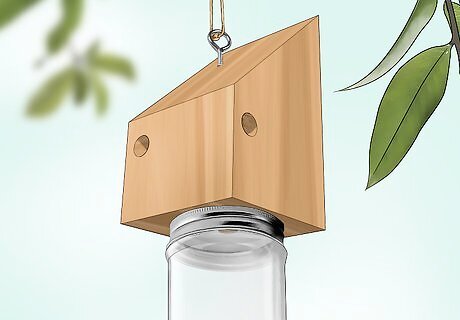
Fit the Mason Jar onto the lid to complete the trap. After hanging up the trap, move the Mason jar toward the lid. It should fit into the ring holding the lid in place. Turn the jar counterclockwise until it hangs in place. When the jar fills with bees, you can unscrew it again to clean it out. The jar is where the bees go when they want to leave. The light attracts them there. It works the same way whether you use a jar, plastic bottles, or another clear material.




















Comments
0 comment